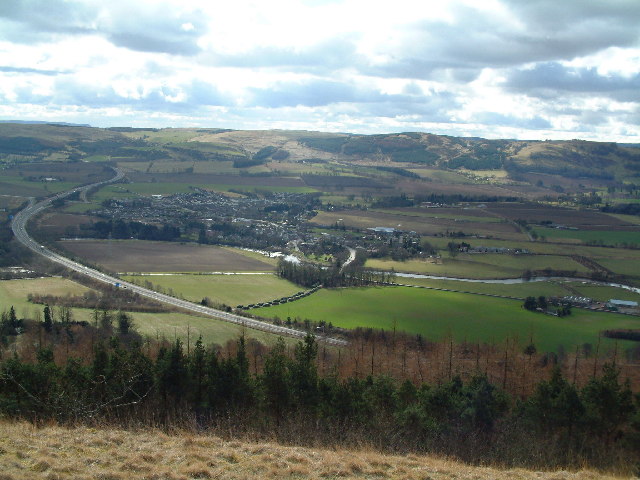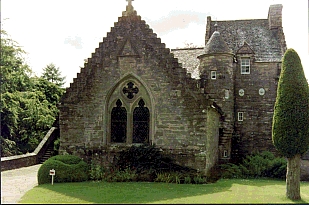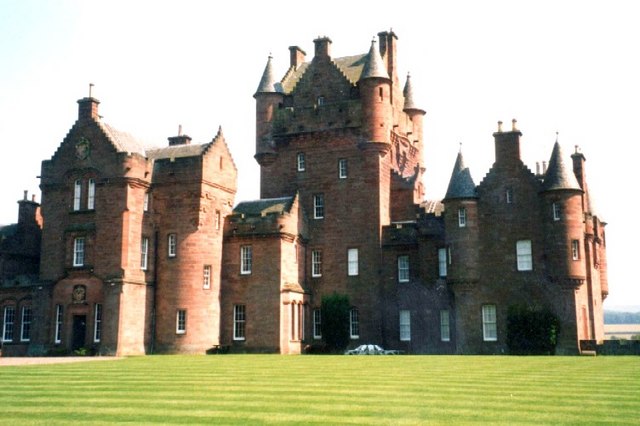|
John Drummond, 12th Of Lennoch
John Drummond, 12th of Lennoch, 5th of Megginch (18 October 1754 – 13 May 1835), was a Scottish politician who served as MP for Shaftesbury. Early life Drummond was born on 18 October 1754. He was the eldest son of the former Katherine Oliphant and Colin Drummond, a Scottish merchant who relocated his family to Quebec. Among his siblings were Elizabeth Drummond (wife of John Hervey, Lord Hervey), Robert Drummond, 6th of Megginch (a Captain of an East Indiaman ship trading with the Far East), Admiral Sir Adam Drummond, 7th of Megginch (who married Lady Charlotte Murray, eldest daughter of the 4th Duke of Atholl), and Gen. Sir Gordon Drummond (who married Margaret Russell, daughter of William Russell of Brancepeth Castle). His paternal grandparents were John Drummond, 10th of Lennoch, 3rd of Megginch, and the former Bethia Murray. His uncle, Adam Drummond, married Lady Catherine Powlett (a daughter of the 4th Duke of Bolton), and his aunt, Jean Drummond, married James Murr ... [...More Info...] [...Related Items...] OR: [Wikipedia] [Google] [Baidu] |
James Stewart-Murray, 9th Duke Of Atholl
James Thomas Stewart-Murray, 9th Duke of Atholl, 14th Baron Strange, 8th Baron Percy (18 August 1879 – 8 May 1957), styled Lord James Stewart-Murray until 1942, was a Scottish peer and soldier. Stewart-Murray was the fourth and youngest son of John Stewart-Murray, 7th Duke of Atholl, and Louisa Moncreiffe, daughter of Thomas Moncreiffe of that Ilk, 7th Baronet. He was educated at Eton and commissioned a second lieutenant in the 1st Battalion of the Queen's Own Cameron Highlanders on 3 January 1900. The following month, he left for South Africa to fight in the Second Boer War. With his battalion, he took part in operations in the Transvaal May and June 1900, including action near Johannesburg and Pretoria (early June 1900) and the Battle of Diamond Hill (11–12 June 1900); and in the Orange River Colony June to November 1900, including action at Wittebergen and Ladybrand. He was promoted to lieutenant on 29 May 1901, and subsequently seconded to serve with the 2nd Regiment o ... [...More Info...] [...Related Items...] OR: [Wikipedia] [Google] [Baidu] |
Earl Of Kinnoull
Earl of Kinnoull (sometimes spelled Earl of Kinnoul) is a title in the Peerage of Scotland. It was created in 1633 for George Hay, 1st Viscount of Dupplin. Other associated titles are: ''Viscount Dupplin'' and ''Lord Hay of Kinfauns'' (1627) and ''Baron Hay of Pedwardine'' (1711). The former two are in the Peerage of Scotland, while the third is in the Peerage of Great Britain. The title of Viscount Dupplin is the courtesy title for the Earl's eldest son and heir. History The Hay clan descends from Norman-born knight Guillaume de la Haye, who was pincerna (cup bearer or butler) to Malcolm IV and William the Lion. Charles I advanced Sir George Hay to the peerage on 4 May 1627 under the titles of Lord Hay of Kinfauns and Viscount Dupplin. On 25 May 1633, Hay was created the Earl of Kinnoull by King Charles I. The Hay family share a common ancestor with the Earls of Erroll. Gilbert de la Hay (died April 1333), ancestor of the Earls of Erroll, was the older brother of Will ... [...More Info...] [...Related Items...] OR: [Wikipedia] [Google] [Baidu] |
George Hay, 2nd Earl Of Kinnoull
Sir George Hay, 2nd Earl of Kinnoull, (1596 – 5 October 1644), styled Lord Kinfauns between 1621 and 1634, was a Scottish peer, military officer, and political official. Biography He was the son of George Hay, 1st Earl of Kinnoull, who was created the Earl of Kinnoull by Charles I of England, King Charles in 1633, and Margaret, daughter of Sir James Halyburton. He was a member of the Privy Council of the United Kingdom, Privy Council, and served as Captain of the Yeomen of the Guard from 1632 to 1635. He was fiercely loyal to as a loyalist to King Charles; he fought in the English Civil War, when he distinguished himself "by unshaken fidelity to his unfortunate sovereign, and gallant and active services as a soldier in his cause." On the death of his father in 1634 he inherited the lands and Lord Kinfauns, Lordship of Kinfauns succeeding as 7th Lord Kinfauns with ratification of his Land registration (Scots law), infeftment by parliament in 1641. In 1643, the earl refused ... [...More Info...] [...Related Items...] OR: [Wikipedia] [Google] [Baidu] |
John Drummond, 8th Of Lennoch
John is a common English name and surname: * John (given name) * John (surname) John may also refer to: New Testament Works * Gospel of John, a title often shortened to John * First Epistle of John, often shortened to 1 John * Second Epistle of John, often shortened to 2 John * Third Epistle of John, often shortened to 3 John People * John the Baptist (died ), regarded as a prophet and the forerunner of Jesus Christ * John the Apostle (died ), one of the twelve apostles of Jesus Christ * John the Evangelist, assigned author of the Fourth Gospel, once identified with the Apostle * John of Patmos, also known as John the Divine or John the Revelator, the author of the Book of Revelation, once identified with the Apostle * John the Presbyter, a figure either identified with or distinguished from the Apostle, the Evangelist and John of Patmos Other people with the given name Religious figures * John, father of Andrew the Apostle and Saint Peter * Pope John (disambigu ... [...More Info...] [...Related Items...] OR: [Wikipedia] [Google] [Baidu] |
Strathearn
Strathearn or Strath Earn (), also the Earn Valley, is the strath of the River Earn, which flows from Loch Earn to meet the River Tay in the east of Scotland. The area covers the stretch of the river, containing a number of settlements in Perthshire. It shares a name with a modern ward used for elections to Perth and Kinross Council. Strathearn was also the name of an ancient province of the Kingdom of Alba, under the authority of a mormaer and then an Earl. More recently, the name has since been used in a number of titles used by the British royal family. History The historic province of Strathearn was bounded on the north by Atholl, north west by Breadalbane, south west by Menteith, south east by Fife, and on the east by '' Perthia''. The earliest attested mormaer of Strathearn is Mael Ísu I, who is recorded fighting alongside David I at the Battle of the Standard in 1138. Unlike some provinces where the holder of the office of mormaer rotated between kin- ... [...More Info...] [...Related Items...] OR: [Wikipedia] [Google] [Baidu] |
Clan Drummond
Clan Drummond is a Highland Scottish clan.Way, George and Squire, Romily. (1994). ''Collins Scottish Clan & Family Encyclopedia''. (Foreword by The Rt Hon. The Earl of Elgin KT, Convenor, The Standing Council of Scottish Chiefs). pp. 120 - 121. The surname is rendered "Druimeanach" in modern Scottish Gaelic.Urquhart, Libby. (1997). ''The Drummonds''. Published by Lang Syne Publishers Ltd. . History Origins of the clan Traditional origins West of Stirling is the parish of Drymen and its name appears to have been derived from the Scottish Gaelic, ''dromainn'' which means a ''ridge'' or ''high ground''. There is a traditional legend that states that the first nobleman to settle in Drymen was a Hungarian prince called Maurice, who accompanied Edgar Ætheling, an Anglo-Saxon prince, on his escape from William the Conqueror and the Norman conquest of England. These royal fugitives were warmly welcomed by Malcolm III of Scotland, who married one of the royal sisters, Margaret, lat ... [...More Info...] [...Related Items...] OR: [Wikipedia] [Google] [Baidu] |
Scottish Feudal Barony
In Scotland, "baron" or "baroness" is a rank of the ancient nobility of the Baronage of Scotland, a hereditary Imperial, royal and noble ranks, title of honour, and refers to the holder of a barony, erected into a free barony by Crown Charter, this being the status of a minor baron, recognised by the crown as noble, but not a peer. The Court of the Lord Lyon representing the monarch in Scotland, institutional writers, the registry of Scots Nobility, the Scottish Law Commission Government Website, UK Government Legislation Website and the Scottish Parliament all refer to the noble title of a Scottish baron. These titles were historically called feudal titles, which is incorrect today. When Scotland abolished feudalism in 2004, baronial titles that were once feudal baronies were transformed into personal dignities in law (or baronage titles), disconnected from territorial privileges. Rights in relation to Parliament Some sources, such as the Manorial Society of Great Britain, M ... [...More Info...] [...Related Items...] OR: [Wikipedia] [Google] [Baidu] |
Megginch Castle
Megginch Castle is a 15th-century castle in Perth and Kinross, in central Scotland. It was the family home of Cherry Drummond, 16th Baroness Strange, Cherry, 16th Baroness Strange. It is now lived in by Lady Strange's daughter, Catherine Drummond-Herdman, her husband and four children. Megginch Castle is a private family home, which is only open for special events. The gardens are home to trees such as ancient Taxus baccata, yews, there is a topiary, and in the spring there is an extensive display of daffodils. The orchard contains two National Plant Collections of Scottish apples, and pears, and cider apples. The gardens are listed on the Inventory of Gardens and Designed Landscapes in Scotland. Historic Scotland, 2 ... [...More Info...] [...Related Items...] OR: [Wikipedia] [Google] [Baidu] |
Brancepeth Castle
Brancepeth Castle is a castle in the village of Brancepeth in County Durham, England, some 5 miles south-west of the city of Durham (). It is a Grade I listed building. History A succession of buildings has been on the site. The first was a Norman castle built by the Bulmers, which was rebuilt by the Nevilles in the late 14th century. For many years the castle was owned by the Neville family until in 1569 it was confiscated by the Crown following the family's involvement in the Rising of the North. There have been a number of other owners since that time. In the early 17th century, the estate was granted by the Crown to Robert Carr, 1st Earl of Somerset, from whom it subsequently confiscated the castle back due to his involvement in a poisoning scandal. In 1636, three men who had bought the castle from the King's Commissioners in 1633 sold it to Ralph Cole of Newcastle. His grandson, Sir Ralph Cole, 2nd Baronet, sold the property on 9 April 1701 to Sir Henry Belaysyse ... [...More Info...] [...Related Items...] OR: [Wikipedia] [Google] [Baidu] |
William Russell (banker)
William Russell (1734–1817) was an English merchant, coal-fitter and banker. He first went into business as a merchant in Sunderland. He then made a substantial personal fortune from coal mining. Background The Russell family has been traced back to Duddon Bridge, near Millom (now in Cumbria). William Russell was the second son of Robert Russell (died 1757) of Rowenlands (also Roanlands), near Haverigg in Cumberland. His uncle Matthew Russell moved to Sunderland in 1717 and was in business there as a timber merchant and shipbuilder. He became blind, and William Russell took over the business. Matthew Russell died childless in 1760. He and Robert each left William £10,000. Coal leases Russell took on a lease for New Washington colliery in 1775; the royalty holder in 1820, in the time of his son as owner, was Sir Wilfrid Lawson, 1st Baronet, of Brayton. He took on a further lease, of Wallsend Colliery, in 1787. The royalties were held by the dean and chapter of Durham Cathedral. ... [...More Info...] [...Related Items...] OR: [Wikipedia] [Google] [Baidu] |
Gordon Drummond
General Sir Gordon Drummond, GCB (27 September 1772 – 10 October 1854) was a Canadian-born British Army officer and the first official to command the military and the civil government of Canada. As Lieutenant Governor of Upper Canada, Drummond distinguished himself on the Niagara front in the War of 1812 and later became Governor-General and Administrator of Canada. Early years Gordon Drummond was born in Quebec City on 27 September 1772. He was of Scottish descent, the son of Colin Drummond (1722–1776), of Megginch Castle, Perthshire, and his wife Catherine Oliphant of Rossie. His sister, Elizabeth married Lord Hervey, one brother, John Drummond married a daughter of John Fane, 9th Earl of Westmorland and another brother, Vice-Admiral Sir Adam Drummond, KCH, married Lady Charlotte Murray, eldest daughter of John Murray, 4th Duke of Atholl. Gordon's father first came to Lower Canada in 1764 as the Quebec agent to the London firm of Sir Samuel Fludyer, Adam Dru ... [...More Info...] [...Related Items...] OR: [Wikipedia] [Google] [Baidu] |




